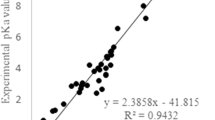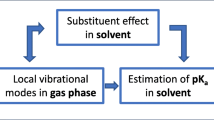Summary
Gas-phase acidities have been calculated for 175 compounds using the PM3 semiempirical molecular orbital model. With some exceptions, PM3 seems to be a useful tool for the investigation of gas-phase acidities. The main problems encountered involve two rather different classes of acids: one which generates small anions (e.g., halide ions, hydride ion, etc.), in which the charge is localized on one atom, and, a second, represented by anions that contain bulky electron acceptor substituents characterized by an extensive negative charge delocalization. In some cases (anilines, amides, alcohols, and phenols) the average error in predicted gas-phase acidity can be significantly reduced by employing an empirically derived correction.
Comparison with AM1 results shows that both methods are of roughly equal quality with the exception of hypervalent molecules where PM3 is better (averaged unsigned errors are 11.8 and 17.0 kcal/mol for PM3 and AM1, respectively).
Similar content being viewed by others
References
Hehre WJ, Radom L, Schlyer, PRv, Pople JA (1986)Ab Initio molecular orbital theory. Wiley, NY
Bingham RC, Dewar MJS, Loo DH (1975) J Am Chem Soc 97:1285
Dewar MJS, Thiel W (1977) J Am Chem Soc 99:4899
Dewar MJS, Zoebisch EG, Healy EF, Stewart JJP (1985) J Am Chem Soc 107:3902
Stewart JJP (1989) J Comput Chem 10:209
Dewar MJS, Dieter KM (1986) J Am Chem Soc 108:8075 and references therein
Koppel IA, Mölder UH, Palm VA (1985) Org React (Tartu) 21:3
Kollmar H (1978) J Am Chem Soc 100:2665
Bartmess JE, Burnham RD (1984) J Org Chem 49:1382
Bartmess JE, Caldwell G, Rozeboom D (1983) J Am Chem Soc 105:340
Kass SR (1990) J Comp Chem 11:94
Dewar MJS, Fox MA, Nelson DJ (1980) J Organomet Chem 185:157
Gordon MS, Davis LP, Burggaf LF, Damrauer M (1986) J Am Chem Soc 108:7889
Olivella S, Urpi F, Vilarrasa J (1984) J Comput Chem 5:230
Siggel MR, Thomas TD, Saethre LJ (1988) J Am Chem Soc 110:91
Koppel IA, Comisarow MB (1980) Org React (Tartu) 17:498
Koppel IA, Mölder UH (1981) Org React (Tartu) 18:42
Stewart JJP (1989) J Comput Chem 10:221
Lias SG, Bartmess JE, Liebman JF, Holmes JL, Levin RD, Mallard WG (1988) J Phys Chem Ref Data 17, Suppl No. 1
Stewart JJP (1983) MOPAC Program Package — QPCE 455
Thiel W, Voityuk AA (1992) Theor Chim Acta 81:391
Author information
Authors and Affiliations
Rights and permissions
About this article
Cite this article
Burk, P., Koppel, I.A. Critical test of PM3 calculated gas-phase acidities. Theoret. Chim. Acta 86, 417–427 (1993). https://doi.org/10.1007/BF01122432
Received:
Accepted:
Issue Date:
DOI: https://doi.org/10.1007/BF01122432




